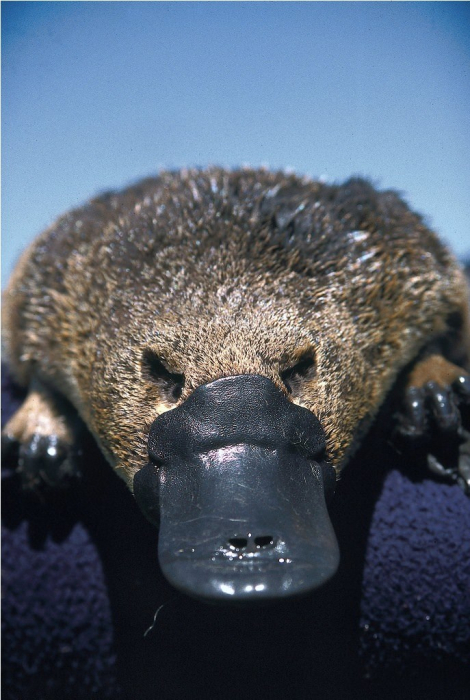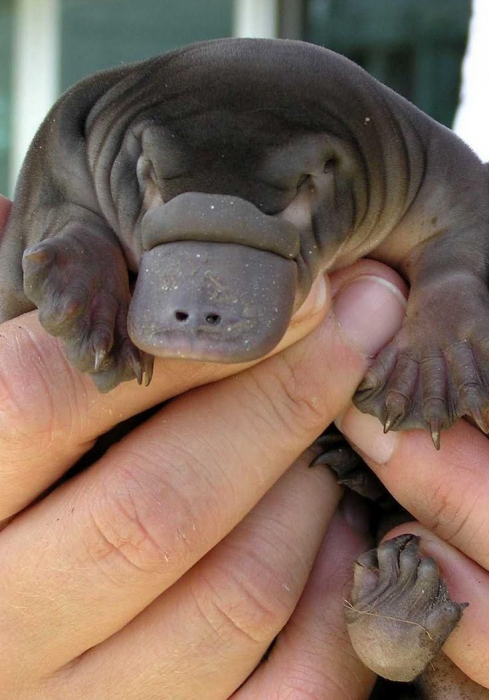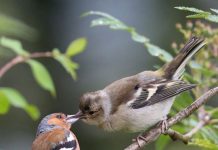On our planet you can meet many amazing, unique creatures. One of them is an animal platypus. This is the only representative of the platypus family. The species belongs to the single-pass order, and the echidnae belong to it. What this animal looks like, where it lives, what it eats, as well as interesting facts about it - read in this article.
Material Content:
View description

Platypus (Ornithorhynchus anatinus) is a strange semi-aquatic mammal weighing less than 2 kg. Its elongated squat torso is covered with thick soft fur. The back is dark brown, the belly is gray or reddish. Body size - 30-40 cm, while males are about one third more females.
The body ends with a flat wide tail resembling a beaver, from 10 to 15 cm in length. Fat accumulates in it. In young animals, the coat covers the tail, which subsequently becomes rare.
The mammal swims beautifully. Its short five-fingered paws work like flippers, with only the front ones, while the hind legs act as a helm. On land, with its strong webbed limbs equipped with sharp claws, the animal can dig the earth, sometimes making whole tunnels to equip itself with a home.
The head of the platypus has a round shape, in the front section there is a flat, duck-like, beak 6.5 cm long and 5 cm wide. It is soft to the touch, its bone is covered with elastic skin, in which there are many nerve endings. Due to this, the mammal has not only a developed sense of touch, but also the ability to electrolocation. Receptors located in the beak can pick up the weak electric fields that form when any living creatures move. This quality helps the platypus in search of prey, it is thanks to him that this awkward-looking animal instantly calculates its food and catches it just as quickly.
Cheek bags are located above the beak.The animal lays food reserves in them. And below, at the base of the beak, there is iron, which produces a secret with a musky smell. In the oral cavity, young individuals have up to 8 teeth, which eventually wear off and are replaced by hard keratinized plates.
Eyes and ears (without auricles) are located on the sides of the head, they are located in grooves with moving edges resembling valves. During diving, they close, protecting the visual and auditory organs. The nasal passages are also closed, therefore, under the water of the platypus, the smell, vision and hearing are “turned off”.
Scientists for a long time could not determine what kind of platypuses belong, they did not even immediately believe in their existence. The fact is that in 1797 only the skin got into England, and the scientific community initially considered this a hoax, as if a beak and a tail of a beaver were sewn to the fur of an incomprehensible creature. But after it was established that this was not a joke, scientists had to believe that such an animal still exists.
And here again disputes arose, already regarding the species affiliation. The presence of a beak, the absence of the urethra (there is only cloaca), reproduction by laying eggs and features of the reproductive system of females (they have only the left ovary functioning), indicated a relationship with birds. A peculiar gait (platypuses set their paws when walking on the sides of the body) reminded of reptiles. And the fact that the babies are fed milk, and the male’s penis is forked and many-headed, as in most representatives of single-pass and marsupials, it was possible to rank these amazing creatures as mammals. This was the decisive factor.
Where do the platypuses live?
The platypus lives in Australia. This is an endemic species - it does not occur on other continents. Its range is vast and extends from the plateau of the Australian and Alps of Tasmania to Quisland. In the northern part, it reaches Cooktown, and in the south these mammals can be found only on the Kangaroo island and along the banks of the Murray-Darling rivers. Probably, in this part of the continent the population is practically not widespread due to water pollution - representatives of the species are very sensitive to this. In addition, they are able to live only in fresh water with a temperature of 25-29.9 ° C.
History reference. These unique animals became known in the XVIII century, during the colonization of New South Wales. The first settlers called them “duckbill” (duckbill), “ducks” (duckmole) and “water moles” (watermole).
Lifestyle
The platypus chooses to live on the shores of fresh water. Here he digs holes up to 10 m long, with one entrance located on the shore, hidden in thickets or tree roots, and the other under water. In the center of the shelter there is an inner chamber where the animal is hiding.
These mammals are predominantly nocturnal, spending up to 10 hours in a row in a pond. They are magnificent swimmers, are able to dive and are able to stay at a depth of up to 5 minutes. They hunt crustaceans, mollusks and tadpoles, eat worms, larvae and algae. On the day of the individual, it is necessary to consume a volume of food, comprising about 25% of its weight. Gathering food in cheek pouches, the mammal floats to the surface and lies on the water, slowly rubbing its jaws.
Despite the fact that individuals are modest in size, they have not so many natural enemies. Sometimes they are attacked by pythons, monitor lizards and sea leopards. Perhaps this is due to the fact that a small animal can stand up for itself. The fact is that the platypus is a poisonous mammal (another similarity to reptiles), horn spurs are located on the hind legs of males (in females they disappear closer to a year old), and the duct connects them to the femoral gland. Here, during the mating season, a toxic “cocktail” is produced that can kill a small animal, for example, a dingo dog. For humans, platypus venom is not deadly, but it is tolerated quite painfully, and edema occurs at the site of damage.However, most often males use spurs, “sorting out relationships” not with animals of other species that are encroaching on their lives, but with rivals during mating fights.
Platypus breeding

Platypuses reach maturity by 12 months. After a day's winter hibernation, which lasts from 5 to 10 days, the mating season begins and lasts from August to November.
Individuals mate in water, and then the female gets out to land. Since the platypus is an egg-laying animal, it needs to dig a flood hole and equip it with a nest of leaves and stems, as well as make earthen plugs. They will protect the masonry from predators and floods. The male does not take part in the preparation of the nest, as well as in the rearing of young animals, and representatives of this species do not create permanent pairs.
14 days after mating, the female lays 1 to 3 eggs. They are small, about 1 cm in diameter, rounded, covered with a dirty white leathery shell. After 10 days, the baby platypus is born - about 25 mm long, naked and blind, their eyes open only by the 11th week of life.
The female feeds the babies with milk, which is excreted from the pores on the stomach. At the same time, she has no glands, in the usual sense, she “sweats” milk. Feeding lasts up to 4 months, and then the cubs begin to go hunting and gradually become independent.
How many platypuses live in nature is unknown. In captivity, their life expectancy is an average of 10 years. However, they can only be seen in Australian zoos. They are very shy and excitable, poorly tolerate a change of scenery. For example, in 1922, one platypus entered the New York Zoo, but he lived in captivity for only 49 days. Other attempts to export these mammals from the mainland were not successful, and breeding them in captivity also failed.
Interesting Facts
Interesting facts about platypuses:
- The closest ancestors of the species lived on the planet more than 4 million years ago. They were similar to modern platypuses, but inferior to them in size;
- these animals are the only mammals with advanced electroreception. The echidna also has electroreceptors, but she practically does not use them in the process of hunting;
- Compared to other members of the mammalian class, platypuses have a low metabolism, and their body temperature is only 32 ° C. It is noteworthy that the animal knows how to regulate it, and, being in cold, not more than 5 ° C water, maintains a normal rate for several hours. This is due to the fact that the level of metabolism in such conditions rises more than threefold;
- The platypus is endemic to Australia and one of its symbols. His image is printed on the reverse of an Australian coin in denominations of 20 cents.
Children can learn about these amazing animals not only from textbooks, but also from the animated series Phineas and Ferb. One of the heroes is Perry, the domestic platypus, who is the secret agent of OBKA (Organization Without a Cool Abbreviation) and is forced to lead a double life full of dangers and adventures. However, the appearance and habits of the cartoon character have little to do with a real animal.












